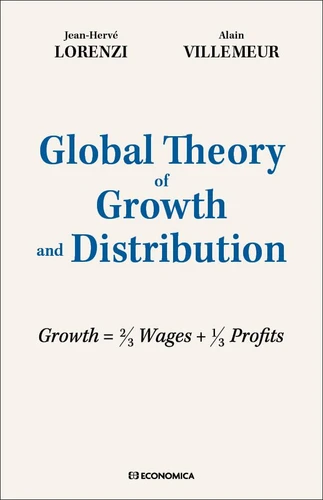Global theory of growth
Par : ,Formats :
- Paiement en ligne :
- Livraison à domicile ou en point Mondial Relay entre le 1 août et le 5 aoûtCet article sera commandé chez un fournisseur et vous sera envoyé 3 à 6 jours après la date de votre commande.
- Retrait Click and Collect en magasin gratuit
- Livraison à domicile ou en point Mondial Relay entre le 1 août et le 5 août
- Réservation en ligne avec paiement en magasin :
- Indisponible pour réserver et payer en magasin
- Nombre de pages112
- PrésentationBroché
- FormatGrand Format
- Poids0.3 kg
- Dimensions15,5 cm × 24,0 cm × 0,8 cm
- ISBN978-2-7178-7271-2
- EAN9782717872712
- Date de parution07/07/2023
- ÉditeurEconomica
Résumé
This book reflects our conviction that the distribution between labour and capital income determines the conditions for satisfactory economic growth. The wage-profit distribution has shifted dramatically in favour of profit over the past several decades in the advanced economies, while economic growth has been steadily declining. Since the Great Recession of 2008, economic slowdown and near stagnation have become widespread despite the unconventional fiscal and monetary policies implemented.
How can we explain these worrying situations ? David Ricardo was right to consider as early as 1817 that income distribution is a major problem in economics. Our Global Theory of Growth and Distribution sheds light on the current situation ; it is based on a new neo-Ricardian model. Thus, we discover that a distribution of two-thirds wages and one-third profits is optimal for sustainable, resilient, job-rich growth in the long run.
Moreover, too high profits penalize growth and productivity, contrary to the supposed trickle-down effects. This new paradigm must be developed to overcome the many economic challenges of the coming decades (climate change, aging, inequalities) that beset advanced economies.
How can we explain these worrying situations ? David Ricardo was right to consider as early as 1817 that income distribution is a major problem in economics. Our Global Theory of Growth and Distribution sheds light on the current situation ; it is based on a new neo-Ricardian model. Thus, we discover that a distribution of two-thirds wages and one-third profits is optimal for sustainable, resilient, job-rich growth in the long run.
Moreover, too high profits penalize growth and productivity, contrary to the supposed trickle-down effects. This new paradigm must be developed to overcome the many economic challenges of the coming decades (climate change, aging, inequalities) that beset advanced economies.
This book reflects our conviction that the distribution between labour and capital income determines the conditions for satisfactory economic growth. The wage-profit distribution has shifted dramatically in favour of profit over the past several decades in the advanced economies, while economic growth has been steadily declining. Since the Great Recession of 2008, economic slowdown and near stagnation have become widespread despite the unconventional fiscal and monetary policies implemented.
How can we explain these worrying situations ? David Ricardo was right to consider as early as 1817 that income distribution is a major problem in economics. Our Global Theory of Growth and Distribution sheds light on the current situation ; it is based on a new neo-Ricardian model. Thus, we discover that a distribution of two-thirds wages and one-third profits is optimal for sustainable, resilient, job-rich growth in the long run.
Moreover, too high profits penalize growth and productivity, contrary to the supposed trickle-down effects. This new paradigm must be developed to overcome the many economic challenges of the coming decades (climate change, aging, inequalities) that beset advanced economies.
How can we explain these worrying situations ? David Ricardo was right to consider as early as 1817 that income distribution is a major problem in economics. Our Global Theory of Growth and Distribution sheds light on the current situation ; it is based on a new neo-Ricardian model. Thus, we discover that a distribution of two-thirds wages and one-third profits is optimal for sustainable, resilient, job-rich growth in the long run.
Moreover, too high profits penalize growth and productivity, contrary to the supposed trickle-down effects. This new paradigm must be developed to overcome the many economic challenges of the coming decades (climate change, aging, inequalities) that beset advanced economies.






















